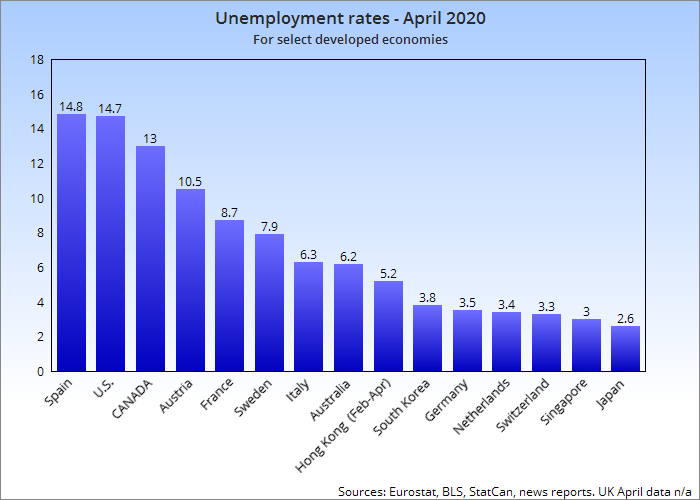MONTREAL ― Since the COVID-19 lockdowns began in March, some 5.5 million Canadians have lost their job or seen hours cut at work. It’s similar south of the border, where an estimated 40 million people had lost work in the crisis as of late May.
Canada’s official unemployment rate has more than doubled, to 13.7 per cent from around 5.5 per cent at the start of the year. In the U.S, the jobless rate quadrupled to 14.7 per cent in April, from 3.4 per cent before the crisis.
It is a stunning toll, one that Canadians and Americans will inevitably feel for years to come, and it’s worse than the unemployment situation in almost all other developed countries.

In the eurozone ― the 19 countries that use the euro ― the unemployment rate in April was 7.3 per cent, up just one percentage point from before the pandemic. (May numbers are not yet available in Europe.) In Germany, the jobless rate ticked up to 3.5 per cent, from 3.4 per cent before the COVID-19 lockdowns.
And then there’s Italy, stricken hard and early in the pandemic, where the economy minister declared that “nobody must lose their job because of the coronavirus.” The jobless rate there fell to 6.3 per cent in April ― though mostly because many people who were jobless before the pandemic stopped looking for work, not because the country is adding jobs.
So how did this happen? How can Canada be seeing a much worse job crisis than Italy? After all, our government hasn’t skimped on the stimulus programs.
Watch: U.K. will cover 80% of redundant workers’ salaries through the pandemic. Story continues below.
In a rapidly unfolding crisis like a pandemic, small decisions can have ripple effects that can have outsized consequences. And as it turns out, Canada ― along with the U.S. ― took a different approach from European countries, and they got very different results.
In essence, European governments have a tradition of wage support programs for business to prevent layoffs; in North America, governments always focused on income supports for those already laid off.
In Italy, Germany and elsewhere in Europe, governments announced very quickly that businesses would receive wage subsidies to keep people employed during the shutdown. The result is that even businesses that were forced to close entirely often kept their workforce, on the expectation they would need them again after the lockdown.
In Germany, for instance, the existing Kurzarbeit system allowed companies to slash their employees’ hours, with the government covering 60 per cent of the lost income. Typically companies top that up and employees end up getting 80 per cent of their regular pay.
In Italy, the Cassa Integrazione Guadagni includes a program where a company with 15 or more employees can cut workers’ hours, and the CIG will cover 80 per cent of wages for up to a year.
France has a similar scheme to Italy’s, and there, the program is currently keeping 10 million people in their private-sector jobs.
The result is that European businesses were able to keep their workforce during the shutdowns. In Canada, as in the U.S., the initial emergency measures didn’t give businesses much hope they could hold on to their staff with help from the government.
Prime Minister Justin Trudeau announced a wage subsidy on March 18 of just 10 per cent of wages, an amount that seemed more symbolic than useful to the business groups that panned it as inadequate.
The U.S. announced a program of loans to businesses on March 25, some of which would be forgivable if businesses kept their staff. There has been no direct wage subsidy, though it is (still) being debated in Congress.
No doubt hearing the feedback from business groups, Canada’s Liberal government quickly expanded the wage subsidy to 75 per cent on March 29, nine days after the original announcement. But in those crucial nine days, many businesses made fateful decisions about layoffs on the expectation that meaningful wage support wasn’t coming.
“Nothing was announced for several weeks, (and the program) basically just started to deliver money a few weeks ago,” Dan Kelly, president and CEO of the Canadian Federation of Independent Business, told HuffPost Canada earlier this week.
“In that time, most employers had to lay off their workers, they didn’t have cash to hang on. … As a result, millions of Canadians became unemployed that might not have.”
There are many scenarios where you would be better off not opening, where you are better off keeping sales low.
Dan Kelly, Canadian Federation of Independent Business
One thing that helped employers make that decision was that, by the time the 75-per-cent subsidy ― known as the Canada Emergency Wage Subsidy, or CEWS ― was rolled out, the government had already announced the $2,000-a-month Canada Emergency Response Benefit (CERB) for the unemployed.
Knowing the CERB was there “made me feel less awful” about laying off staff, the owner of an independent bookstore in Western Canada told HuffPost, asking not to be identified, out of concern for professional repercussions.
The owner would bring staff back to pre-pandemic levels “in a heartbeat” if the wage subsidy was there ― but it isn’t for their store. That’s because to qualify for the CEWS, a business has to have seen at least a 30-per-cent drop in revenue. If you rise above that level, you no longer qualify for the benefit.
The bookstore owner estimates their business has seen a drop of 26 per cent in sales. The store is operating online and through curbside pickup, but staff have been rehired only at reduced hours.
“I don’t want to put my staff at risk or our families, or some of our customers who are quite elderly and frail,” the owner said. But “it would be nice if we had jobs to come back to after. How do you balance that? It’s really challenging.”
Without financial support, there is little they can do; the owner isn’t even drawing a salary, and is living off their laid-off partner’s CERB payments. Thanks to online sales, “it’s been an easier pivot for us, but for others (in the community) … some of them won’t reopen at all,” the owner said.
‘Perverse signals’
And in its current form, the CEWS could actually be slowing down the return to pre-pandemic hiring levels. As it’s designed, the CEWS creates an incentive for businesses to keep their revenue suppressed, CIBC economist Avery Shenfeld wrote in a report last month.
The cutoff for qualifying “could have a business opting to shorten hours of operation if, for example, sales were about to creep above that (30-per-cent) mark,” Shenfeld wrote.
Kelly said he has been hearing from members that this is happening, and worries the CEWS is sending “perverse signals” to business owners on how they should be operating.
“There are many scenarios where you would be better off not opening, where you are better off keeping sales low,” he said.
But he noted that Prime Minister Justin Trudeau appears aware of the problem and has signalled that “during the reopening phase a different approach is necessary.”

Kelly is encouraged by the fact the federal Liberals have extended the CEWS to August, as he figures it will be more useful ― and the uptake will be higher ― now that lockdowns are ending and businesses are opening up again. If so, the CEWS could end up helping to rehire some of the people that it arrived too late to help at the start of the pandemic.
“It’s a credit to the government” that it is staying flexible on policy as the crisis unfolds, he said.
Even those who point out the shortcomings in the program don’t lay much blame at policymakers’ feet.
“These nuances aren’t a sign that the initial decisions were flawed,” Shenfeld wrote. “Simple designs were needed to get them up and running in a hurry. But just as a patient has to be carefully weaned off pain medication, policymakers need to adjust their prescriptions as we take small steps towards economic health.”
Calling all HuffPost superfans!
Sign up for membership to become a founding member and help shape HuffPost’s next chapter
Credit: Source link